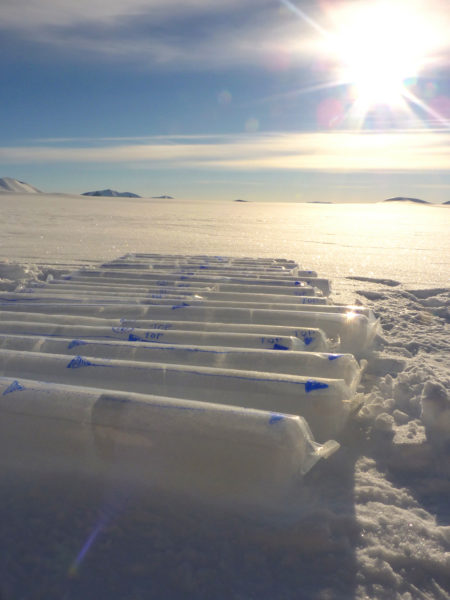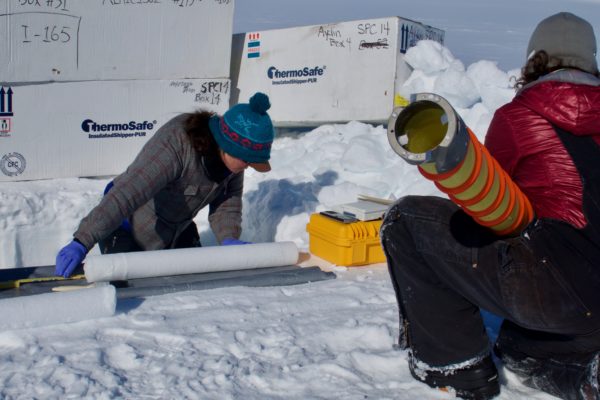
Ices cores the team drilled in the Arctic ready for shipping. Photo credit: Ali Criscitiello, University of Alberta
TORONTO, May 14, 2020 – An international environmental agreement to regulate the use of chemicals depleting the ozone layer may have inadvertently allowed higher levels of other harmful chemicals to flourish, new research co-led by York University and Environment and Climate Change Canada has found.
The 1987 Montreal Protocol on Substances that Deplete the Ozone Layer was designed to phase out ozone-depleting chemicals, chlorofluorocarbons (CFCs), such as freon used in older air conditioners.
But these replacement compounds, thought to be a better alternative, degrade into products that do not break down in the environment and have instead continually increased in the Arctic since about 1990.
“Our results suggest that global regulation and replacement of other environmentally harmful chemicals contributed to the increase of these compounds in the Arctic, illustrating that regulations can have important unanticipated consequences,” says Assistant Professor Cora Young of the Faculty of Science and the paper’s corresponding author.
It is important to study these products of CFC replacement compounds, short-chain perfluoroalkyl carboxylic acids (scPFCAs), before more of them are phased in over the next few years as they can adversely impact human health and the environment. They are part of the perfluoroalkyl substances (PFAS) class of man-made chem icals used in commercial products and industrial processes that are currently receiving a lot of attention.
These scPFCAs are products of chemicals used in the fluoropolymer industry in automotive, electrical and electronic applications, industrial processing and construction.

Team members prepare ice cores in the Arctic. Photo credit: Ali Criscitiello, University of Alberta
“Our measurements provide the first long-term record of these chemicals, which have all increased dramatically over the past few decades,” says Young. “Our work also showed how these industrial sources contribute to the levels in the ice caps.”
They can travel long distances in the atmosphere and often end up in lakes, rivers and wetlands causing irreversible contamination and affecting the health of freshwater invertebrates, including insects, crustaceans and worms.
Current drinking water treatment technology is unable to remove them, and they have already been found accumulating in human blood as well as in the fruits, vegetables and other crops we eat.
The researchers measured all three known scPFCA compounds over several decades in two locations of the high Arctic and found all of them have steadily increased in the Arctic, particularly trifluoroacetic acid.
The researchers acknowledge the importance of the Montreal Protocol’s positive impact on the ozone and climate but point out that even the best regulations can have unintended negative impacts on the environment.
The research is published in the journal Geophysical Research Letters.
PHOTOS:
https://news.yorku.ca/files/Ice-Cores-from-the-Arctic-scaled.jpg
https://news.yorku.ca/files/Team-members-collect-ice-cores-from-the-Arctic-scaled.jpg
https://news.yorku.ca/files/Ali-Criscitiello-of-U-Alberta-scaled.jpg
https://news.yorku.ca/files/Ali-Criscitiello-from-U-Alberta-drilling-scaled.jpg
-30-
York University champions new ways of thinking that drive teaching and research excellence. Our students receive the education they need to create big ideas that make an impact on the world. Meaningful and sometimes unexpected careers result from cross-disciplinary programming, innovative course design and diverse experiential learning opportunities. York students and graduates push limits, achieve goals and find solutions to the world’s most pressing social challenges, empowered by a strong community that opens minds. York U is an internationally recognized research university – our 11 faculties and 25 research centres have partnerships with 200+ leading universities worldwide. Located in Toronto, York is the third largest university in Canada, with a strong community of 53,000 students, 7,000 faculty and administrative staff, and more than 300,000 alumni. York U's fully bilingual Glendon Campus is home to Southern Ontario's Centre of Excellence for French Language and Bilingual Postsecondary Education.
Media Contact:
Sandra McLean, York University Media Relations, 416-272-6317, sandramc@yorku.ca

